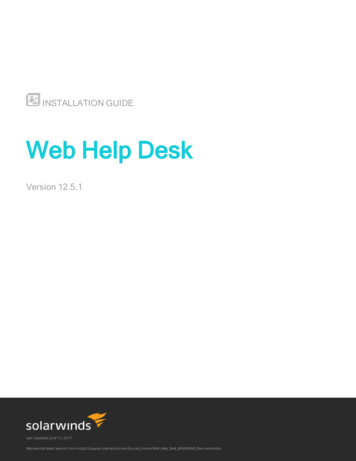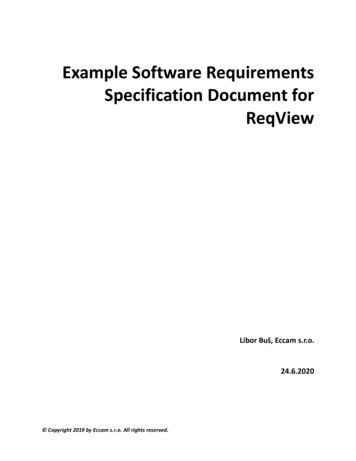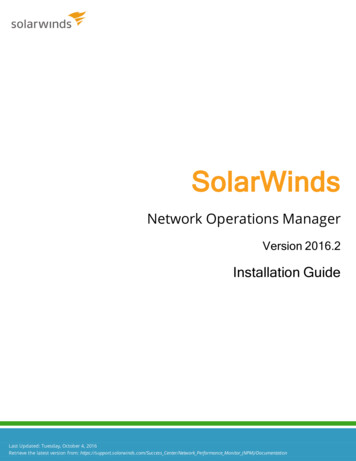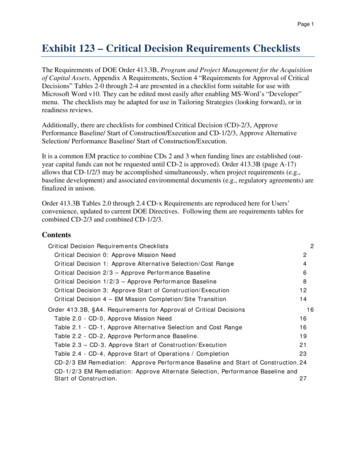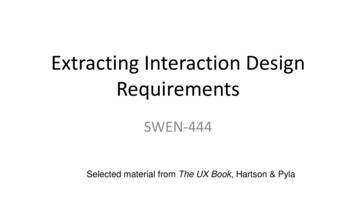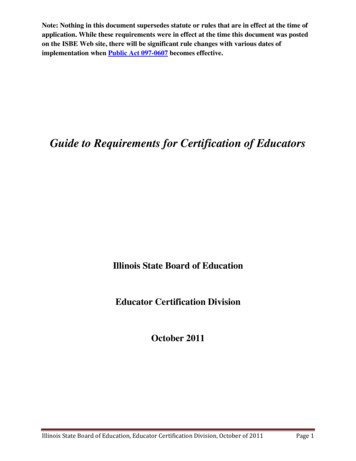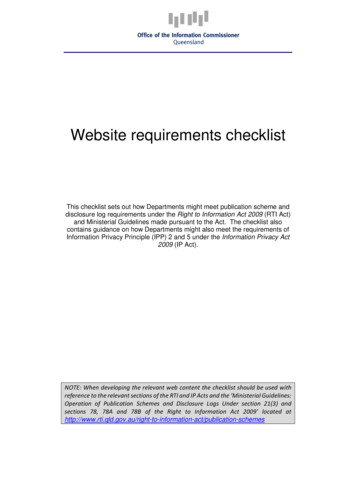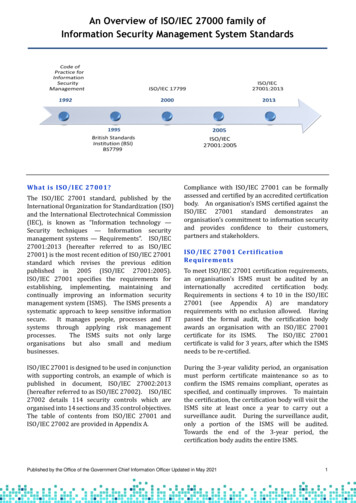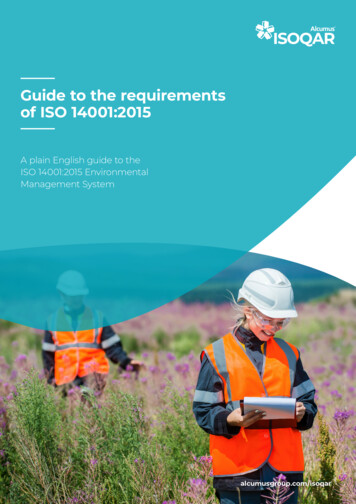
Transcription
Guide to the requirementsof ISO 14001:2015A plain English guide to theISO 14001:2015 EnvironmentalManagement Systemalcumusgroup.com/isoqar
ContentsIntroductionRequirements of the standard2The purpose of this guide6Clause 1 - Scope3Why do organisations getISO 14001 certified?6Clause 2 - Normative references6Clause 3 - Terms and definitions7Clause 4 - Context of theStructure of theISO 14001 standard4High level structure5PDCA9101315161819organisationClause 5 - LeadershipClause 6 - PlanningClause 7 - SupportClause 8 - OperationClause 9 - Performance evaluationClause 10 - ImprovementSummaryWho is UKAS?The purpose of this guideMany people new to management systems areunder the impression that an ISO standard is aset of rules that dictates how an organisationshould go about its business. That is not correct.This guide looks at all the clauses and mainsub clauses and describes them in plainEnglish. You will also find practical adviceon measures you might want to considerimplementing in your organisation. You shouldread this document alongside the standard.An ISO standard is the document whichcontains a set of requirements (with someoccasional guidance) for the frameworkof your management system. It is nota set of procedures and targets - theyare for you to establish in a way whichis relevant to your organisation andthe context in which you operate.This guide doesn’t go through the standardline by line. ISO standards sometimesartificially separate important topics butin the real world you won’t find it workslike that in your workplace. So, this guidetakes a more holistic approach to minimisethe need to jump back and forth.If you’ve never looked at an ISO standard before,it may appear daunting. That’s a lot to do withthe fact that a standard has to be written in away that applies to all organisations of everysize, in every sector, in every location aroundthe world. So occasionally an ISO standard canseem vague, and sometimes lapse into jargon.This guide is not a substitute for the standarditself nor for the expert guidance of aprofessional, but it will help demystify some ofthe more difficult-to-grasp aspects of ISO 14001.2
IntroductionYou usually want to maximiseeverything to do with yourorganisation, like brand awareness,revenue and profits. But when itcomes to the environment, youwant to minimise your impact.organisation identify, manage, monitor andcontrol environmental issues to improvewhat’s known as your ‘environmentalperformance’. This is largely achieved throughmore efficient use of resources, reducedwaste and compliance with regulations.The implementation of a certifiedEnvironmental Management System(EMS) will not guarantee compliance withlegislation nor give you immunity fromprosecution. However, it does provide aframework for you to minimise the risks ofbreaches of legislation due to the bettercontrol of processes. Risk is further reducedas a result of the increased awareness andknowledge among employees that comes fromimplementing and maintaining the system.The reasons for wanting to do this are manyand varied. There’s now much greater social,political and regulatory pressure to do so.Customers are keen to work with suppliersthat have sound environmental credentials.Whatever your motivation, one of the best waysto achieve your environmental goals is with ISO14001:2015 - the international standard for anEnvironmental Management System (EMS).In a nutshell, an Environmental ManagementSystem certified to ISO 14001:2015 (usuallyjust referred to as ISO 14001) can help yourISO 14001 is good for the environmentand good for your business.Why do organisations get ISO 14001 certified? Reduce environmental impact and protectthe environment – quantify, monitorand control the environmental impactof your operations including preventionof pollution and specific commitmentsrelevant to your organisation Control suppliers – ISO 14001 preventsyour good work being undone by supplierswith poor environmental performance Win more business – certificationis increasingly a requirement whenbidding to win work with the publicsector or larger corporations. Cost savings – through better energymanagement, efficient use of resourcessuch as water and reduced waste Legal compliance – comply withregulations and avoid fines andsanctions against your business3
Structure of theISO 14001 standardHigh level structureThe document that describes this high levelstructure is known as Annex SL. This makeslife much easier when implementing andmaintaining standards. Because there arecommon clauses, you can combine yourmanagement systems to create one ‘IntegratedManagement System’. This introduces simplicity(especially when adding new standards)and saves you time, effort and money.ISO 14001:2015 benefits from Annex SL.Since many organisationsimplement and maintain variousmanagement systems at thesame time, ISO (the organisationwhich develops the standards)has revised and restructuredmany key standards over recentyears so that they share commonstructures, terms and definitions.Stage in the processClause1 Scope2 Normative references3 Terms and definitions4 Context of the organisation4.1 Understanding the organisation and its context4.2 Understanding the needs andexpectations of interested parties4.3 Determining the scope of theenvironmental management system4.4 Environmental management systemPlan5 Leadership5.1 Leadership and commitment5.2 Environmental policy5.3 Organisational roles, responsibilities and authorities6 Planning6.1 Actions to address risks and opportunities6.2 Environmental objectives andplanning to achieve them7 Support7.1 Resources7.2 Competence7.3 Awareness7.4 Communication7.5 Documented informationDo8 Operation8.1 Operation planning and control8.2 Emergency preparedness and responseCheck9 Performance evaluation9.1 Monitoring, measurement, analysis and evaluation9.2 Internal audit9.3 Management reviewAct10 Improvement10.1 Nonconformity and corrective action10.2 Continual improvement44
PDCAThen you begin on the loop again, thusensuring continual improvement.PDCA (the Plan-Do-Check-Act Cycle)is most closely associated with qualitymanagement. Yet it’s at the heart ofall ISO management systems.It’s inherent to all management systemsand the key to improving environmentalperformance. The graphic shows in more detailhow each clause of ISO 14001 fits into the cycle,with the relevant clause number in brackets.The premise is quite simple. You planto do something, you do it, you checkyour results and then act to 5)ctANeeds andexpectations ofrelevantinterested parties(4)Improvement(10)You will find the same high level structurein other standards such as ISO 9001:2015(Quality Management), ISO 27001:2015(Information Security) and ISO 45001:2018(Occupational Health & on(8)PlOrganisationand its context(4)PerformanceEvaluation(9)Results ofthe EMSckIt’s also sometimes known as theDeming Cycle or the Shewart Cycle.CheProducts andandProductsservicesservices
APlanctChRequirements of the standard:Clauses 1 to 3DoeckNone of the first three clauses set out any requirements.However, you really should familiarise yourself with theterminology in Clause 3 as you’ll get a bit lost when lookingat later clauses if you don’t have a basic understanding.Environmental impactClause 1 - ScopeThis clause simply explains that the purpose ofthe standard is to set out the requirements of anenvironmental management system to improveenvironmental performance and its applicabilityto any organisation of whatever size in any sector.The impact is the outcome of an aspect. Forexample, emissions to the air (the aspect)may result in warming (the impact). Youmay consider ‘aspect and impact’ to bethe equivalent of ‘cause and effect’.Clause 2 - Normative referencesYour environmental management system shouldensure that your impacts are measurable. Onceyou can monitor everything, you are better placedto apply controls to reduce your environmentalimpact, such as reduced emissions and waste.Environmental performanceThis clause usually lists any additionaldocuments referred to that form part of thestandard itself. There are none for ISO 14001.Environmental policyClause 3 - Terms and definitionsThis is a formal statement from topmanagement of your intentions relatingto your environmental performance. It’snormally in writing, brief and outlines yourcommitment to complying with regulationsand aiming for continual improvement.There are many terms and definitions given inthe standard, many of which are self-explanatory.Most of them are common to all of the majorISO standards. However, there are a few whichare worth highlighting here that are usedthroughout the standard and more generallywith reference to environmental management.Environmental management systemThis is the set of policies, procedures, plans andactions in their entirety that you use to manageenvironmental aspects, fulfil complianceobligations and address risks and opportunities- and much more. In essence, it’s everything thatyou do in order to achieve ISO 14001 certification.EnvironmentThis does not relate to the ‘businessenvironment’ in which you operate. It refersto the actual physical surroundings in whichyou operate including: air, water, land,natural resources, flora, fauna, humans andthe interrelationships between all those.Life cycleThis relates to consecutive and interlinkedstages of a product or service system, fromthe beginning to end. This includes rawmaterials, design, production, transportation,use, end-of-life treatment and disposal.Environmental aspectThis curious term relates to anorganisation’s activities, productsand services that can interact with theenvironment. So, for example,it could be pollutants released into the air, orhazardous waste you dispose of. The standardalso refers to ‘significant’ environmentalaspects. Generally, you can consider animpact is ‘significant’ if there are legalenvironmental requirements relating to it.6
APlanctChRequirements of the standard:Clause 4Doeck4 Context of the organisationClause 4, like the previous 3, doesn’t really set out any requirements but it isessential to pay close attention because it sets the parameters for everythingthat follows.4.1 Understanding theorganisation and its contextPESTLE analysisIn essence, you are required to take astep back and look at the entirety of yourorganisation and the context in which youoperate - and that includes both the businessenvironment and natural environment.This established tool is particularly usefulwhen developing an EMS. This exerciseinvolves identifying the POLITICAL,ECONOMIC, SOCIAL, TECHNOLOGICAL,LEGAL and ENVIRONMENTAL issuesthat impact upon your organisation.Many organisations start this exercise byperforming one or both of the following:You can do all of this by brainstorming withyour colleagues across all departmentsand through interviews, questionnaires,surveys and even independent researchinvolving all interested parties (see 4.2).SWOT analysisIn trying to understand the context ofyour organisation, you should consider theinternal and external issues that impactupon your organisation and your EMS.These can be categorised as STRENGTHS,WEAKNESSES, OPPORTUNITIES andTHREATS. Simply use these words as headingsand populate the lists beneath them.The general idea is that you need to considerhow your organisation fits in with theworld at large and how it impacts on boththe environment and everyone with aninterest in your organisation - sometimesknown as stakeholders or, in the languageof ISO 14001 - interested parties.Note - at this stage, you aren’t coming up withsolutions to the challenges - that comes later.7
4.2 Understanding the needs andexpectations of interested parties4.3 Determining the scopeof the environmentalmanagement systemInterested parties are any persons orgroups concerned with or affected by yourorganisation’s environmental performance. Forexample, it could be the Environment Agencywho is interested in emissions and waste, yourshareholders who are interested in profitsand your neighbours who are unhappy withthe noise from lorries unloading at the crackof dawn. You may want to involve interestedparties in your SWOT and PESTLE analyses.Once you have completed the aboveexercises you can determine the scope ofthe environmental management system.This is important because when you get yourcertificate, it will say on it what the ‘scope’ ofyour certification is, in other words, the parts ofyour organisation (such as design, production,distribution) and physical locations to whichthe certification applies. For example, if you’rein the business of metal fabrication with sitesacross the country, you cannot get a certificatefor the HR function at your head office andclaim it applies to the entire organisation. AUKAS accredited certification body will beable to advise on the scope with no charge.You should, for each interested party, identifywhat their needs and expectations are. Youwill possibly then see that some are conflicting.Within this exercise you must consider yourcompliance obligations. In other words, thelaws and regulations which you must abideby. The chances are that you’re already awareof these obligations - if not, you should seekthe advice of specialist consultants for yourindustry sector. Of course, this applies whetheryou’re seeking to implement ISO 14001 or notto ensure you stay on the right side of the law.4.4 Environmentalmanagement systemFrom the above exercises, you then get tothe heart of the matter which is to developyour Environmental Management System(EMS). This clause simply states that youneed to develop one, based on what you’velearned from the steps above, and that youneed to continually improve it. The rest of thisguide will deal with how that’s achieved.Regulatory Bodies are principally:Environment Agency (England)Natural Resources WalesScottish Environmental Protection AgencyDepartment of Agriculture, Environmentand Rural Affairs (Northern Ireland)HSE also enforces some environmental legislation88
APlanctChRequirements of the standard:Clause 5Doeck5 LeadershipWithout effective leadership from the very top, your EMS is doomed to fail.Not only do you need buy-in and support from the most senior people inthe organisation to get this project off the ground, but ‘top management’will need to demonstrate in an audit that they genuinely are committed!5.1 Leadership and commitment5.2 Environmental policy‘Top management’ is a term that’s usedin ISO standards and refers to the groupof people who direct and control anorganisation at the highest level. It’s likely toinclude, but not be limited to, people withDirector, Head and Chief in their job titles.Signing the Environmental Policy (see alsodefinition in Clause 3) is essential. This has tobe documented. This policy is often quite brief,only a page or so. It sets out the broad high levelaims and should refer to your commitment tocompliance with legislation, protection of theenvironment and continual improvement. Thepolicy doesn’t set the measurable targets - itsimply makes clear that you are committed.Top management therefore needs todemonstrate their leadership andcommitment. It’s not good enough just to sayyou are committed - there needs to be realevidence. This could include, for example:Just enter ‘environmental policy’ into any searchengine and it will return many examples fromorganisations to give you an idea of what onelooks like. But remember - it has to be yourpolicy, in the context of your organisation. Youwon’t get away with a cut and paste job! Ensuring that resources are available todevelop, implement and maintain the EMSe.g. dedicated staff; staff with the EMSas part of their responsibilities; freeingup time to review and audit systemsand providing budget to support it.The reason you can see so many of these onlineis that it needs to be available to all interestedparties. So, put it on your noticeboardsand on your website as a minimum. Providing evidence that the EMS andenvironmental concerns are part of theprocess of developing the business planand strategy. Minutes from meetingsmay be used as evidence of this.5.3 Organisational roles,responsibilities and authoritiesWhilst top management takes ultimateresponsibility for the EMS, they also needto identify and assign other employees’roles, responsibilities and authorities. Ina smaller organisation, it may be that topmanagement takes on these roles, but in largerorganisations it’s more likely that other stafftake responsibility for the day-to-day operationof the EMS. It should be made very clear, andunderstood by all employees (so therefore,documented) exactly who is responsible for: Demonstrating that these issues arecommunicated to staff, for example oninduction, at team briefings, through formaltraining (and allocation of a training budget),references to it in the Staff Handbook etc. Ensuring that the systemconforms with ISO 14001 Reporting on the performance ofthe EMS to top management9
APlanctChRequirements of the standard:Clause 6Doeck6 PlanningThis is one of the biggest sections of the standard and arguablythe most important. You need to get your planning right otherwiseyou’ll set off in the wrong direction and waste time and money.If you look at this clause in the standard, you’ll notice there’s a lot of jumpingback and forth. Here, we’re going to look at it in a holistic way.Broadly speaking, this is where you start to focus on the details of your managementsystem as it relates to the environment. It’s very much about establishing therelationship between your organisation and the environment, identifying legalrequirements that relate to your activities, then defining your objectives and targets- all the while being mindful of the need to seek continual improvement.6.1 Actions to address risksand opportunitiesAn established technique for addressingrisks and opportunities involves a basic riskassessment approach and drawing up anEnvironmental Aspects & Impacts Register.(Refer back to Clause 3 - Terms and Definitionsto remind yourself of the meanings of thesephrases.) You need to include all environmentalaspects (6.1.2) of your activities, products andservices that you can control and influence,and their associated environmental impacts,from a life cycle perspective (again, look atthe Terms and Definitions). Considerationshould be given to any abnormal andreasonably foreseeable emergency situations.Here’s a simplified example of a register:This clause is in two main parts with the firstfocusing on actions to address risks andopportunities. Here, you start making useof all the information you gathered in Clause4 when you developed your understandingof the context of your organisation.The standard says that you must developprocesses that address the issues identified.This could include procedures and writtenwork instructions. (Remember, you don’tneed to document every last detail,but you need to exercise judgementand ensure the level of documentationallows you to exercise proper mpactRiskLevelImpactLevelResponsibilityOperationof boilerEmission of SO2,N2O, CO2Pollution of air,global turingof productUse of waterDepletion ofnatural heavy rainDischarge of soiland gravel to waterPollution of waterHighLowSite ManagerUndergroundfuel storageDischarge offuel to landLand andgroundwaterpollutionLowHighImpactLevelOps Director10
You will note that the register also incorporatesother items that are required by the standardto identify the level of risk (that is, the likelihoodof it happening), the severity and whether ornot an emergency plan is in place. You should,of course, have documented emergency plansin these situations. We’ll cover that later.Indeed, you will probably want to add muchmore detail to the register. For example, youmay want to include details of frequencyof testing, impact on the business, theemergency actions to take etc. It couldvery easily become a large and unwieldydocument, so you may wish to considerusing software dedicated to this task.You must also identify your complianceobligations (6.1.3) and the register is agood place to record these as it thenmakes the link between your aspects,impacts and legal requirements.For those significant environmental aspectsthat you have identified, you need to takeplanning action (6.1.4) to address themand ensure compliance. You should alsodevelop actions to meet the opportunitiesyou have identified - this is, of course,critical for continual improvement.Underpinning everything in Clause 6 is theneed to be able to demonstrate that you areactually in control of your environmentalaspects and impacts. This is not explicitlycovered in the standard but is integral tothe concept of continual improvementand the Plan-Do-Check-Act principle.What you can see in this section is that youaren’t really being asked to do anythingdifferent to what you would normally doas part of a thorough business planningprocess - it’s just that the focus of yourattention is on environmental issues,rather than, for example, sales.11
6.2 Environmental objectivesand planning to achieve themYou must also show how they relate to yourcompliance obligations, how you are goingto monitor them and what you are actuallygoing to do to achieve your objectives.For this, you need to identify who will beresponsible, what resources they will have attheir disposal, what your deadlines are andhow you will analyse the results. Just as youwould with any other business objective.The second major part of Clause 6 is quiteeasy to understand. Setting objectivesshould be something that comes naturallyto you when running an organisation.You might think that setting goals shouldcome earlier on, but you can’t really setyour environmental objectives (6.2.1) untilyou’ve got a grasp of all the facts. Thissection is less about meeting your legalobligations and managing risk and moreabout setting your own targets for continualimprovement and then planning actions toachieve environmental objectives (6.2.2).Gap AnalysisAlthough ISO 14001 doesn’t refer toa Gap Analysis, and it isn’t an actualrequirement, it can be useful, particularlyfor smaller companies that don’t havesomeone dedicated to operating theEMS. It’s good for helping you to identifywhere to start when you set out onyour ISO 14001 journey - you may besurprised to find out just how much youare doing already, without realising!You can’t just come up with any old easyto-achieve objectives. They must beconsistent with your environmentalpolicy (6.2.1a), since all parts of your EMSshould be interlinked. The tried and testedapproach is to use SMART objectives: Specific MeasurableYou don’t need to write an essay on all ofthis but you should keep it documented,otherwise, how will you be able todemonstrate to the auditor that you areexercising control? You could do it in asimple table based on something like theone below, or use some software to do it: Achievable Realistic vehicle fleetwith moreefficientmodelsMethodsExchangelighting forenergy efficientalternative. Installmotion eferenceESOSregulationsOps managerMonitor utilityusage beforeand after.Review currentfleet. Assesscurrent mileageand emissionsindicators toassess suitablereplacements.TargetDateEnd ofOctober2020StreamlinedEnergy & CarbonReportingRegulations 2019ref EA001Energy Act 2013EnvironmentalProtectionAct 1990Fleet ManagerEnd ofMarch2021Finance Act2000Road Vehicle(Construction& Use) Regs 198612ref EA002
APlanctChRequirements of the standard:Clause 7Doeck7 SupportThis clause relates to the actual things you do to make your EMS work. Youneed to make sure you provide the resources required, that staff are up tothe task and that everyone’s aware of your policy and what their role is.7.1 Resources7.3 AwarenessThe resources referred to could include humanresources, infrastructure, technology andfinancial support. This could be everythingfrom allocating a couple of hours’ timefrom a colleague to audit systems right upto constructing an entire drainage system.It all depends on your organisation.All personnel involved in any activities thatimpact on your environmental performancemust have appropriate awareness of theenvironmental policy and the environmentalaspects and impacts associated with theirwork. You don’t want to turn this into a negativeexperience so you should also ensure they knowhow they can make a positive impact, althoughof course they need to have the appropriateresources and competence as outlined in 7.2.7.2 CompetenceAnyone involved in doing work that affectsyour environmental performance must becompetent enough to help you achieve yourenvironmental objectives. You therefore needto firstly establish what level of competenceis required so that you can recruit or trainstaff accordingly. You may want to performa training needs analysis and develop askills matrix to identify gaps. Once the gapshave been identified, you must addressthem. You should keep documented recordsof all this, possibly in personnel files.If you outsource work, the same requirementsfor competence apply to the contractors.That said, failure is not acceptable. Youmay wish to set targets for individualsand include them in performance reviewsas you would for any other aspect oftheir work. This demonstrates as muchas anything to an auditor that your EMSis an integral part of your business.13
7.4 Communication7.5 Documented informationYou can only raise awareness with effectivecommunication. This is something of an oldchestnut in the workplace, with the topicregularly topping the list of things in theworkplace that colleagues are dissatisfiedwith. So make full use of all channels such asthe staff handbook, noticeboards, intranet,email reminders, team briefings etc. Theauditors will be looking out for this.The final sections of this clause focuses ondocumented information. Whilst you willneed an EMS manual, which shows how youare compliant with all the clauses, this clauseextends to more than that. Documentedinformation is important for two key reasons: To provide you with the data andinformation you need to enableyou to run your EMS properlyMoreover, in the case of an EMS, you also needto communicate not just internally to colleaguesbut also externally if it’s required for you toremain legally compliant (for example, reportingto official bodies and regulators). So preparea timetable of what needs communicating towhom and when and ensure you stick to it. To provide evidence to an auditor that youare complying with the ISO 14001 standardTake a look at the standard here becauseit’s quite clear on the requirements andthere’s little room for misinterpretation.But there are a few points worth making.By the way, don’t forget that you alsoneed to communicate with contractorsto whom you outsource any work.First, while documented records can beon any type of media - not just paper orelectronic files on your computer - theyneed to be readily traceable, identifiableand controlled, for example with a date,author and/or reference number.Second, records must also be easilyretrievable and securely stored (perhapswith a password where appropriate).Finally, they should be clearly understood bythose who play a part in the managementsystem. So use plain English!Organisations often wonder about the extentand depth of documented information required.Clause 8 deals with this topic too. In fact,even without an EMS, you probably alreadykeep a lot more information than you realise.Overall, the level of documentation needsto be ‘proportionate’ to your organisation.Much will depend on the nature of yourbusiness, but you must as a minimum: Show you are compliant where required Have the necessary records to be able toimprove your environmental performance Have procedures to allow you to exercisecontrol over significant environmentalaspects and impacts (not necessarilyall aspects) (see also 8.2).However, you will inevitably need morethan this. This is where the advice of anISO 14001 consultant can be invaluable.14
APlanctChRequirements of the standard:Clause 88 OperationFor your EMS to actually work in a way that allows you to controlyour environmental aspects and risks, you need to define how you’regoing to control your processes - and implement those actions.You need to set about this with reference to Clause 6. While that clause relates toplanning the actions to deal with the detailed aspects and risks, Clause 8 is aboutdetermining exactly what you’re going to do and actually implementing processes.You also need to be mindful of the life cycle perspective, that is,exercising control over everything from the raw material/designstage through to the final disposal of the product/service.8.1 Operational planningand controlThe first part of this clause requires you todetermine how you’re going to exercise controlover operations. You will undoubtedly havewritten procedures in many cases, but you willalso need to consider these ‘in the round’, forexample, also looking at broader managementissues such as purchasing policy and training.You need to keep your eye on the biggerpicture: your operational controls are toprevent deviation from the environmentalpolicy and objectives, and to ensure youmeet your compliance obligations.8.2 Emergency preparednessand responseThe second part of the clause says you musthave appropriate procedures for emergencyresponses to deal with risks that could resultin a significant impact on the environment.You also need to test, review and revise theseprocedures periodically and ensure everyoneis trained to deal with emergency situations.Remember, you also need to be able to applysimilar co
to achieve your environmental goals is with ISO 14001:2015 - the international standard for an Environmental Management System (EMS). In a nutshell, an Environmental Management just referred to as ISO 14001) can help your Reduce environmental impact and protect the environment quantify, monitor and control the environmental impact

